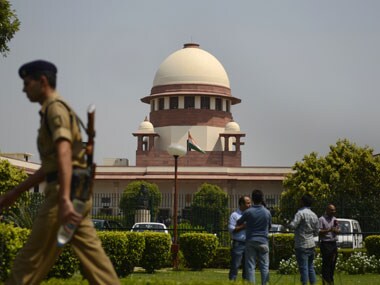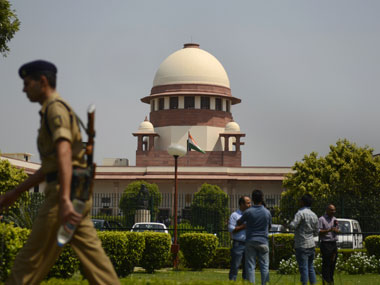The Supreme Court is again treading on dangerous territory. It is repeatedly
muscling into executive terrain
using populist causes to take on a quasi-executive role. The latest exhibit in this usurpation of legislative or executive power is the Supreme Court’s decision yesterday (13 May) to lay down
guidelines on the use of politicians’ pictures on government advertisements.
Henceforth, only the president, the prime minister and the chief justice of India’s pictures can be used in official ads. [caption id=“attachment_2242724” align=“alignleft” width=“380”]
 Supreme Court of India. AFP[/caption] Before one gets into why this is an unwarranted extension of judicial reach, let me be clear: the use of taxpayers’ money for semi-political purposes - or the building of personality cults, as the Supreme Court bench pointed out - is abhorrent. However, the issue of “gross wastage of public funds” has to be taken up by statutory auditors like the Comptroller and Auditor General (CAG), the executive, the parliament, and finally voters. Rival politicians and civil society groups need to convert wastage of resources into electorally significant issues so that they are stopped. The building or debunking of “personality cults” is not for the courts to adjudicate on. Guidelines on government ads cannot be decreed by the courts. Their job is to interpret the law, not decide what the law should be on how public money should be used or not misused. Unaccountable judges should not decide how money should be spent. The Supreme Court order is wrong on several counts, and parliament in fact should assert itself and make a law restricting court jurisdiction in such matters. Consider the sheer number of lines the court has crossed with this issue. First, what is or is not wastage of public funds is not something the courts should decide. If the courts were so concerned about the wastage of taxpayers’ money
why don’t they cut their own vacation time or reduce the pendency of cases first?
Consider the sheer amount of national time and resources wasted on litigation that continues for decades. A Salman Khan case can take 13 years to reach a verdict and a Jayalalithaa case 19 years - and still no justice is seen to be done. The court is needlessly entering areas it cannot enter when its own backyard is a good enough example of wastage of taxpayer resources. Second, the way the Supreme Court decided this case is also unacceptable. It set up its own expert committee under Prof N R Madhava Menon and accepted most of its suggestions, brought out under the title Government Advertisements (Content Regulation) Guidelines 2014
. Since when has public spending become a matter for courts to give guidelines on? This is parliament’s territory, fair and square. By setting up a committee and framing rules for government ads, the court is essentially becoming both a law-making body and its executing authority. The court did the same with it Special Investigation Team (SIT) on black money. Instead of focusing on the law, it has gotten right into its implementation in the area of black money. Now it is doing so with government spending priorities. This is unacceptable. If governments won’t pursue black money cases, the courts can’t decide they will do it. By the same logic, if courts can’t deliver justice or interpret the law responsibly, would they allow government to get into the business directly? Third, the Supreme Court bench, headed by Ranjan Gogoi, also seems to have forgotten that India is a federal country. If the PM’s photo can be used along with the President, by the same token a Chief Minister’s photo should be usable along with the Governor’s within states. India is not run from Delhi. The bench order is sure to be contested by state governments. In effect, the SC has created more cause for more litigation and is party to wastage of more taxpayer funds. Fourth, one wonders why the chief justice should ever want his photo in a government ad – even if involves a court event. The CJI’s job is that of chief guardian of the constitution’s provisions and the ordinary citizen’s rights. The CJI ought not to be a part of any government ad - except for ads involving court functions. But do these functions need to carry his photo? The purpose of such ads is to inform, and this purpose can be served without using a mugshot of the CJI. One wonders why the CJI was even in the picture in this judgment. Fifth, let me repeat the larger question: is it the court’s job to decide how taxpayers’ money is to be used at all? If it can decide how a government ad is issued today, or how black money should be brought back, tomorrow it can decide that the country spends too much on defence and not enough on poverty alleviation, and mandate a committee to make suggestions on how to change the allocations. Consider what a position the court has gotten itself into. Today, if an aggrieved taxpayer feels hounded by the taxman, he or she can approach to courts to give him or her protection. But what happens if the court’s own SIT is the cause of the grievance? Will the court restrain its own SIT? The Supreme Court has begun acted extremely unwisely of late. The judicial system at the top has enough on its plate to keep itself busy for decades without taking on jobs best left to elected representatives and the executive. What the courts are doing now is no different from what politicians are doing: take on populist causes at the urgings of busy body civil society pressure groups. The civil society groups have learnt to use the courts for short-cut solutions to problem afflicting society as a whole. And the courts are playing along. Maybe, the PM did have a point about the courts being in awe
“five-star activists”.
Unwittingly, it is setting the stage for yet another confrontation with the executive.
Supreme Court of India. AFP[/caption] Before one gets into why this is an unwarranted extension of judicial reach, let me be clear: the use of taxpayers’ money for semi-political purposes - or the building of personality cults, as the Supreme Court bench pointed out - is abhorrent. However, the issue of “gross wastage of public funds” has to be taken up by statutory auditors like the Comptroller and Auditor General (CAG), the executive, the parliament, and finally voters. Rival politicians and civil society groups need to convert wastage of resources into electorally significant issues so that they are stopped. The building or debunking of “personality cults” is not for the courts to adjudicate on. Guidelines on government ads cannot be decreed by the courts. Their job is to interpret the law, not decide what the law should be on how public money should be used or not misused. Unaccountable judges should not decide how money should be spent. The Supreme Court order is wrong on several counts, and parliament in fact should assert itself and make a law restricting court jurisdiction in such matters. Consider the sheer number of lines the court has crossed with this issue. First, what is or is not wastage of public funds is not something the courts should decide. If the courts were so concerned about the wastage of taxpayers’ money
why don’t they cut their own vacation time or reduce the pendency of cases first?
Consider the sheer amount of national time and resources wasted on litigation that continues for decades. A Salman Khan case can take 13 years to reach a verdict and a Jayalalithaa case 19 years - and still no justice is seen to be done. The court is needlessly entering areas it cannot enter when its own backyard is a good enough example of wastage of taxpayer resources. Second, the way the Supreme Court decided this case is also unacceptable. It set up its own expert committee under Prof N R Madhava Menon and accepted most of its suggestions, brought out under the title Government Advertisements (Content Regulation) Guidelines 2014
. Since when has public spending become a matter for courts to give guidelines on? This is parliament’s territory, fair and square. By setting up a committee and framing rules for government ads, the court is essentially becoming both a law-making body and its executing authority. The court did the same with it Special Investigation Team (SIT) on black money. Instead of focusing on the law, it has gotten right into its implementation in the area of black money. Now it is doing so with government spending priorities. This is unacceptable. If governments won’t pursue black money cases, the courts can’t decide they will do it. By the same logic, if courts can’t deliver justice or interpret the law responsibly, would they allow government to get into the business directly? Third, the Supreme Court bench, headed by Ranjan Gogoi, also seems to have forgotten that India is a federal country. If the PM’s photo can be used along with the President, by the same token a Chief Minister’s photo should be usable along with the Governor’s within states. India is not run from Delhi. The bench order is sure to be contested by state governments. In effect, the SC has created more cause for more litigation and is party to wastage of more taxpayer funds. Fourth, one wonders why the chief justice should ever want his photo in a government ad – even if involves a court event. The CJI’s job is that of chief guardian of the constitution’s provisions and the ordinary citizen’s rights. The CJI ought not to be a part of any government ad - except for ads involving court functions. But do these functions need to carry his photo? The purpose of such ads is to inform, and this purpose can be served without using a mugshot of the CJI. One wonders why the CJI was even in the picture in this judgment. Fifth, let me repeat the larger question: is it the court’s job to decide how taxpayers’ money is to be used at all? If it can decide how a government ad is issued today, or how black money should be brought back, tomorrow it can decide that the country spends too much on defence and not enough on poverty alleviation, and mandate a committee to make suggestions on how to change the allocations. Consider what a position the court has gotten itself into. Today, if an aggrieved taxpayer feels hounded by the taxman, he or she can approach to courts to give him or her protection. But what happens if the court’s own SIT is the cause of the grievance? Will the court restrain its own SIT? The Supreme Court has begun acted extremely unwisely of late. The judicial system at the top has enough on its plate to keep itself busy for decades without taking on jobs best left to elected representatives and the executive. What the courts are doing now is no different from what politicians are doing: take on populist causes at the urgings of busy body civil society pressure groups. The civil society groups have learnt to use the courts for short-cut solutions to problem afflicting society as a whole. And the courts are playing along. Maybe, the PM did have a point about the courts being in awe
“five-star activists”.
Unwittingly, it is setting the stage for yet another confrontation with the executive.
SC ban on neta photos on govt advts is another example of judicial over-reach
R Jagannathan
• May 14, 2015, 17:44:07 IST
Government waste a lot of taxpayers’ funds by using politicians’ pictures in government ads. But is it the Supreme Court’s job to decide how government funds should be used? This is yet another case of judicial over-reach.
Advertisement
)